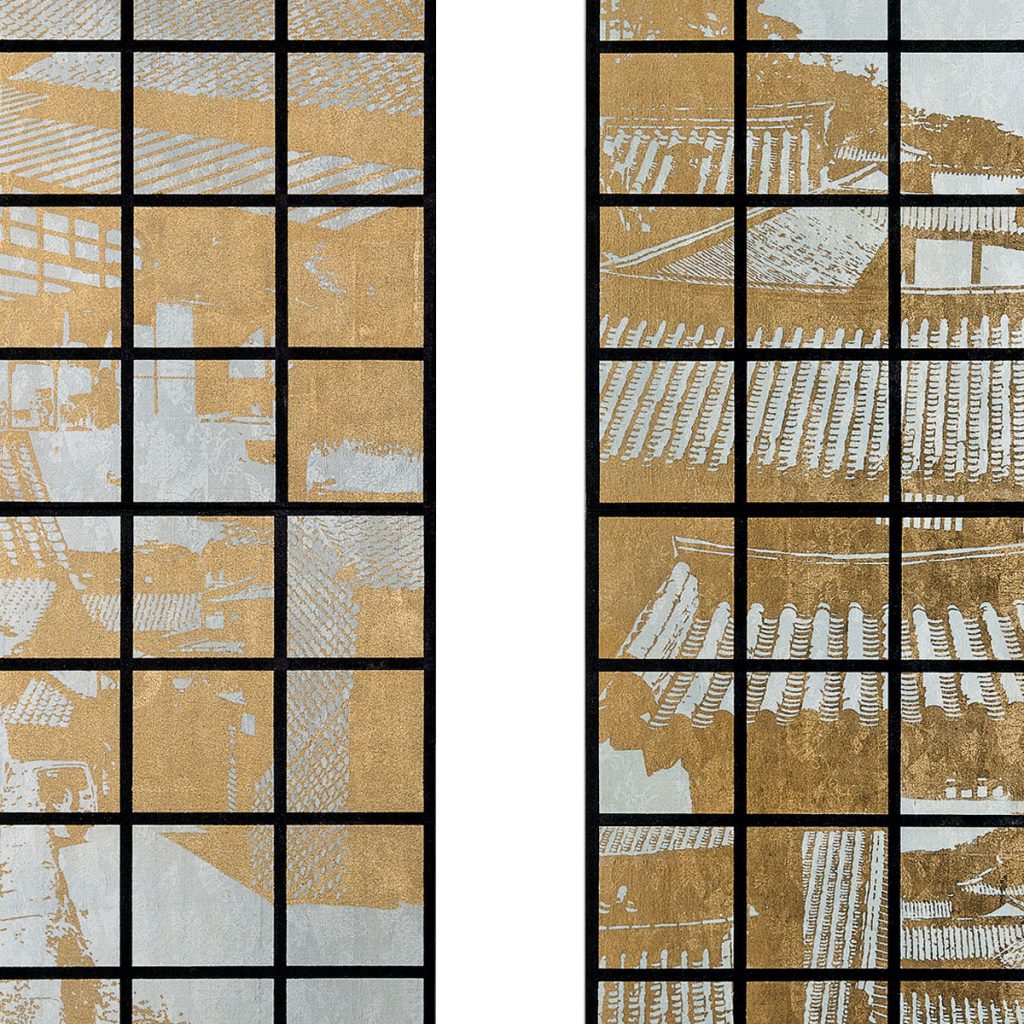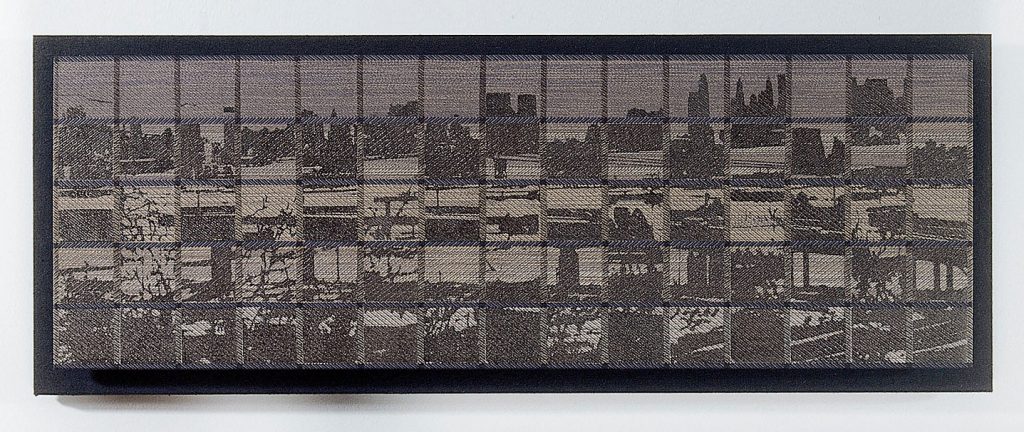
silk damask, silver leaf; screenprint, impressed metal leaf, 48” x 24” x 1” 1990
13gk Pulguk-sa, Kyong-Ju, Glen Kaufman
silk damask, silver leaf; screenprint, impressed metal leaf, 48” x 24” x 1” 1990
photo by Tom Grotta
We were saddened to learn of the loss of talented artist and educator Glen Kaufman last month. Born in Fort Atkinson, Wisconsin in 1932, Kaufman attended the University of Wisconsin-Madison on an Air Force ROTC scholarship, where he met his wife and earned a Bachelor’s Degree in 1954. Following his Air Force service, he enrolled at Cranbrook Academy of Art, earning an MFA degree in Weaving & Textiles in 1959. In 1960, he received a Fulbright Scholarship and attended the State School of Arts & Crafts in Copenhagen. Upon returning to the US, he worked as a designer for Dorothy Liebes in New York City. He returned to Cranbrook Academy as educator, heading the Fibers Department until 1967. In 1967, he was hired by Lamar Dodd as associate professor of Art at the University of Georgia, where taught for over 40 years. He was an honorary member of the Surface Design Association for life and elected into the American Craft Council College of Fellows in 1988. His papers, dated from 1957-2011, were donated to the Archives of American Art at the Smithsonian in 2015. The papers primarily document his travels and student work through biographical material, journals, printed materials, and artwork. Included are 15 travel journals, two sketchbooks, biographical material, professional correspondence, teaching files, photographs of Kaufman and works of art, works of art including sketches and weaving samples, two handwoven knotted pile rug samples and printed material. An oral biography of Kaufman with curator Josephine Shea is found on the Smithsonian situate: https://www.aaa.si.edu/download_pdf_transcript/ajax?record_id=edanmdm-AAADCD_oh_366203.

Glen Kaufman, handwoven silk twill, silver leaf; screenprint, impressed metal leaf
10” x 30” x 1”, 1997
photo by Tom Grotta
From 1983 on, Kaufman divided his time between homes in Athens, Georgia and Kyoto, Japan.. “I have set about creating my work in a foreign place – Kyoto – for half of each year since 1983,” he wrote. “The images in my work can be seen as shadows cast on shoji screens or glimpses of a world seen through a personal window.
In these ‘window views’ I have struggled to achieve a synthesis of my two worlds – tile roofs in Asia; skylines of cities and towns in America. Images of architecture in gold or silver leaf float behind grids on silk panels both large and small,” Kaufman wrote. His work in the US and Japan involved photographs and gold leaf, which he used to capture the architecture of each locale and to reveal aspects of these differing worlds. A grid motif, present in most of these pieces, reflects the prevalence of the grid in Japanese architecture.”The grid fragments the image and at the same time provides a familiar framework, allowing the viewer to perceive the entire image, yet concentrate on the small square.

Glen Kaufman
photo collage, screen print and impressed silver leaf on handwoven kasuri silk, 70” x 17”, 2002
photo by Tom Grotta
“The work evolves from my photographs, photographs that are transformed into strong black-and-white images that express the reality of the subject. These strongly contrasting images are printed onto a silk fabric by screening a special paste over a grid. Subsequently, gold or silver leaf is impressed into the cloth. When the excess leaf is removed, the grid is revealed and the image floats on a surface behind the window grid.The metal leaf I use has inherent reflective qualities that vary depending on the type, color, thickness, and weave of the ground cloth. The reflection of light on the leaf and silk – which changes depending on the light source and the time of day – give an inner life and dynamic visual energy to these works.”
Kaufman’s work appeared in more than 60 solo exhibitions in New York, Boston, Kyoto, Berkeley, Tokyo, Sapporo, Honolulu, San Francisco, Osaka, Nagoya, Seattle, Seoul, Busan, Atlanta and more than 130 group exhibitions in North America, Europe and Asia. His works are in the permanent collections of more than 20 museums, including the Museum of Art and Design, NY; The Art Institute of Chicago; Ba Tang Gol Art Center, Seoul; The Cleveland Museum of Art; Juraku Museum, Kyoto, Japan; Long House Foundation, San Francisco; H.M. de Young Museum, San Francisco; and the Smithsonian Institution, Renwick Gallery, Washington, DC.
